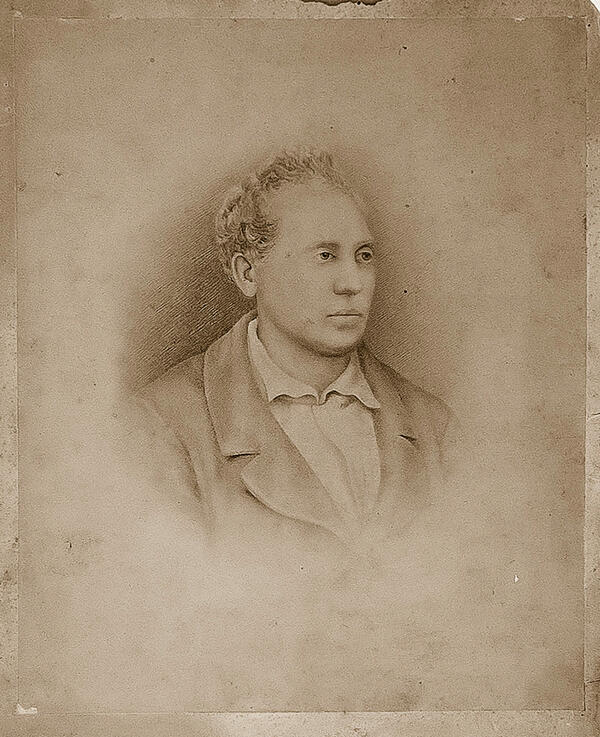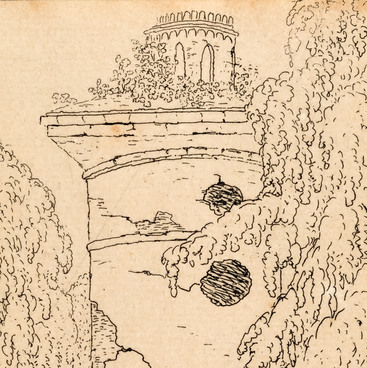The photograph of the unaccounted portrait from the collection of the museum depicts Evgeniy Boratynskiy in the last years of his life. This period was highly controversial for the poet. On the one hand, his everyday life was happy family time, household errands and home comfort, on the other – he was facing a creative and belief crisis and feeling of loneliness.
Beginning from the second half of the 1830s, there is a breaking point in the life of Boratynskiy, caused by the severance of relations with his closest friend at the time - the Slavophile philosopher Ivan Kireevskiy. They became friends towards the end of 1828. Soon Kireevsky’s friendship became as necessary to Boratynsky as the carefully constructed family idyll. Communication with Kireevsky was based on common emotional and intellectual aspirations, but was soon destroyed by unconfirmed rumours and speculation.
This is when, Boratynskiy distanced himself from Moscow acquaintances and poetic affairs and effectively withdrew himself in the family circle. He does not make any literary plans, he does not design new poems, he does not participate in literary debates.
Most of his life is filled with household work and arrangements at the Muranovo estate near Moscow. In 1839, there were seven children in the family. Moreover, Boratynsky took care of the management of the estates of his wife and her family. Thus, household errands occupied almost all of the poet’s free time.
The poetic result of Boratynskiy’s solitary life in Muranovo became the book “Twilight”, the first “author”s cycle” in Russian literature in its new understanding that was characteristic of the early 20th-century poetry.
A measured family life was necessary for Boratynskiy, but in reality a close household circle limited him. Later works of the poet are focused on one subject -- about loneliness and futility of life (“The world I see as in fog…”). He is haunted by the idea of the need to go beyond the family circle: “I want sun and leisure, uninterrupted privacy and silence, if possible unlimited”, - writes Boratynskiy to his publisher PletnEv about the planned trip to Italy. This is exactly the mood you see in the portrait.
Beginning from the second half of the 1830s, there is a breaking point in the life of Boratynskiy, caused by the severance of relations with his closest friend at the time - the Slavophile philosopher Ivan Kireevskiy. They became friends towards the end of 1828. Soon Kireevsky’s friendship became as necessary to Boratynsky as the carefully constructed family idyll. Communication with Kireevsky was based on common emotional and intellectual aspirations, but was soon destroyed by unconfirmed rumours and speculation.
This is when, Boratynskiy distanced himself from Moscow acquaintances and poetic affairs and effectively withdrew himself in the family circle. He does not make any literary plans, he does not design new poems, he does not participate in literary debates.
Most of his life is filled with household work and arrangements at the Muranovo estate near Moscow. In 1839, there were seven children in the family. Moreover, Boratynsky took care of the management of the estates of his wife and her family. Thus, household errands occupied almost all of the poet’s free time.
The poetic result of Boratynskiy’s solitary life in Muranovo became the book “Twilight”, the first “author”s cycle” in Russian literature in its new understanding that was characteristic of the early 20th-century poetry.
A measured family life was necessary for Boratynskiy, but in reality a close household circle limited him. Later works of the poet are focused on one subject -- about loneliness and futility of life (“The world I see as in fog…”). He is haunted by the idea of the need to go beyond the family circle: “I want sun and leisure, uninterrupted privacy and silence, if possible unlimited”, - writes Boratynskiy to his publisher PletnEv about the planned trip to Italy. This is exactly the mood you see in the portrait.



